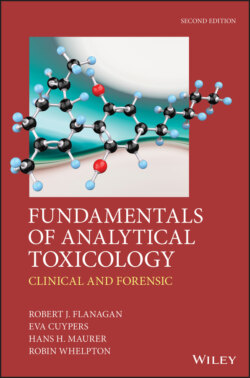Читать книгу Fundamentals of Analytical Toxicology - Robin Whelpton - Страница 16
1 Analytical Toxicology: Overview 1.1 Introduction
ОглавлениеAnalytical toxicology is concerned with the detection, identification, and measurement of drugs and other foreign compounds (xenobiotics) and their metabolites, and in some cases endogenous compounds, in biological and related specimens. The analytical toxicologist can play a useful role in the diagnosis, management, and indeed the prevention of poisoning, but to do so a basic knowledge of clinical and forensic toxicology is essential. Moreover, the analyst must be able to communicate effectively with clinicians, pathologists, coroners, police, members of the legal profession, and a range of other people. In addition, a good understanding of analytical chemistry, clinical chemistry, pathology, clinical pharmacology, pharmacokinetics, and occupational and environmental health is essential.
The use of physicochemical techniques in the detection, identification and measurement of drugs and other poisons in body fluids and tissues has its origins in the development of forensic toxicology. Important contributions came later from work to improve food safety and from occupational toxicology. Major advances in analytical methodology followed the introduction and application of refined physicochemical techniques such as spectrophotometry and chromatography in the late 1940s. In particular, ultraviolet (UV) and infra-red (IR) spectrophotometry, together with visible spectrophotometry (colorimetry), and paper and ion-exchange column chromatography were widely used. In the 1960s paper chromatography was largely superseded by thin-layer chromatography (TLC) as this latter technique offered advantages of speed of analysis and lower detection limits.
Improved instrumentation for UV/visible spectrophotometry (UV/Vis), spectrophotofluorimetry, atomic absorption spectrophotometry (AAS), electrochemistry, X-ray diffraction, nuclear magnetic resonance (NMR), and neutron activation analysis led to these techniques being applied to particular problems. However, whilst some more traditional methods still have their uses, gas and liquid chromatography (GC and LC, respectively), often linked to mass spectrometry (MS) in its various modes, on the one hand and immuno- and enzyme-based assays on the other, are the techniques that are used most widely today (Table 1.1).
Table 1.1 Methods for the analysis of drugs and other organic poisons in biological samples
| Principle | Technique |
| Chemical | Colour test |
| Electrochemical | Biosensors Differential pulse polarography (DPP) |
| Spectrometric | High resolution mass spectrometry (HRMS)Mass spectrometry (MS)Nuclear magnetic resonance (NMR)Spectrophotofluorimetry (SPFM)Ultraviolet/visible absorption spectrophotometry (UV/Vis) |
| Kinetic | Flow-injection analysis (FIA) |
| Chromatographic | Gas chromatography (GC), includes gas–solid chromatography (GSC) and gas–liquid chromatography (GLC)(High performance) liquid chromatography [(HP)LC](High performance) thin-layer chromatography [(HP)TLC]Ion-exchange chromatography (I-EC)Supercritical fluid chromatography [SFC] |
| Electrophoretic | Capillary (zone) electrophoresis [C(Z)E]Capillary electro-chromatography (CEC)Ion mobility spectrometry (IMS)Micellar electrokinetic (capillary) chromatography (MEKC) |
| Ligand immunoassay | Cloned enzyme donor immunoassay (CEDIA)Enzyme-linked immunosorbent assay (ELISA)Enzyme-multiplied immunoassay technique (EMIT)Fluorescence polarization immunoassay (FPIA)Latex agglutination test (LAT)Microparticle enzyme immunoassay (MEIA)Radioimmunoassay (RIA) |
| Enzyme-based assay | Alcohol dehydrogenase – ethanolAryl acylamide amidohydrolase – paracetamol |
